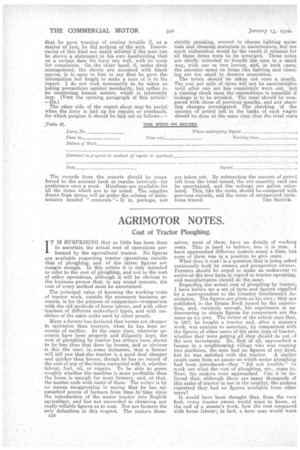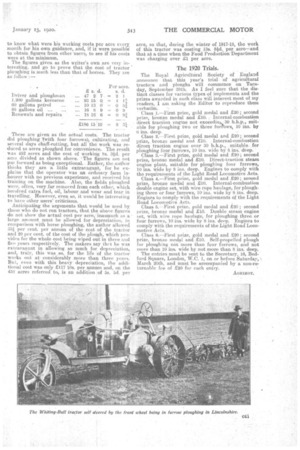AGRIMOTOR NOTES.
Page 20

Page 21

If you've noticed an error in this article please click here to report it so we can fix it.
Cost of Tractor Ploughing.
. T IS SURPRISING that so little has been done to ascertain the actual cost of operations per
formed by the agricultural tractor. No figures are available respecting tractor operations outside that of ploughing, and of the latter figures are meagre enough. In this article it is only intended to refer to the cost of ploughing, and not to the cost ofother operations, although it will be obvious to the business person that, in any sound concern, the cost of every method must be ascertained.
The principal value of knowing the working costs of tractor work, outside the necessary business accounts, is for the purpose of comparison—comparison with the old methods of horse labour, and with other 'tractors of different make stand types, and with machines of the mane make used by other people.
Many a farmer has'declared that horses are cheaper in operation than tractors, when he has kept accounts of neither. At the same time, wherever accounts have been properly and diligently kept, the cost of ploughing by tractor has always been shown to be less than that done by .horses, and so obvious is this the case; insome instances, that a fanner will tell you that4he traitor, is a good deal cheaper and quicke,r'than horses; though he has no record of the cost of any of the items connected with it, whether labour, fuel, 'oil, or repairs.' To be able to guess roughly whether the machine is more profitable than
. • the horse is enough for most farmers, and, at that, the matter ends with ninny of them. The writer is by no means exaggerating in 'saying that he has ap
• psoached scores of farmers from time„.to'time since the introduction of the motor tractor into English agriculture, and has not succeeded hi obtaining any really reliable figures as to cost. Nor are farmers the only defaulters in this respect. The makers them
n38 selves, most of them, have no details of working costs. This is hard. to believe, but it is true. I have approached different makers many a tinie, but none of them was in a position to give costs: . What does it cost ? is a question that is being, asked continually both by owners and prospective owners. Farmers should be urged to make an endeavour to i arrive at the true facts n regard to tractor operating, and manufacturers should do the same.
Regarding the actual cost of ploughing by tractor,
have before me a set of facts and figures supplied by a correspondent to the Country Gentlemen's Asaociation. The figures are given as his own ; they are published in the Estate Book issued by the association, and, curiously enough, his experience in endeavouring to obtain figures for comparison are the same as my own. The writer of the article says that, in 1917, he bought a tractor and, after a season's work, was anxious to ascertain, by comparison with the figures of other users of the mine type. of tractor, whether they were gettingall they should do out of the new investment. He, first of all, approached a farmer in a neighbouring village who was running two machines, the min had no figures of any.kind, but he was satisfied. with the tractor. A similar result came from an estate on which motor ploughing had been introduced—they " did not trouble!' to work out what the cost of ploughing, etc., came to. Next, the makers were approached. Can it he believed that, altboogh. there are many -thousands of this make of tractor in use in the eofintry, the Makers regretted they had no figures available from other -users? Ip would have been thought that, from the very first, every tractor owner would want to know, at the end of a season's work, how the cost compared with horse labour; in fact, a keen man. would want to know what were his working costs. per acre every month for his own. guidance, And, if it were possible to obtain figures from other Users, to see if his costs were at the minimum.
The figures given as the writer's own are very interesting, and go -to prove that the cost of tractor ploughing is much less than that of horses. They are as follow
These are •given as the actual costs. The tractor did ploughing '(with four furrews), cultivating, and several days chaff-cutting, but all the work was reduced to acres pletighed for convenience. The result was 452 acres and the cost of Working 8s. .3,Ad. per acre divided as shown above... The figures are not put forward as being exceptionaL Rather, the author thinks they are 'a little extravagant, for he explains, that the operator • Was an ordinary farm laloourer with no previous experience, and received his . training on the machine. Also, the fields ploughed were, often, very lax removed from each other, which involved extra fuel, oil, labdur and wear and tear in travelling. However, even .so, it would be interesting to have other users'. criticisms.
Anticipating the -arguments that. would be used by those who do not run tractors, that the above figures do not show the actual cost per acre,-inasmuch as a large amount must be 'allowed for depreciation, in comparison with horse ploughing, the author allowed 33* per cent. per annum of the cost of the tractor 'and 20 per cent, of the cost of the plough, which provides for the whole cost being Wiped main' three and five years respectively. The makers say thpt he was extravagant -in allowing so Much for depreciation, and, truly, this was ,uso, for the life of the tractorworks out at considerably more than three years. But, even with, this heavy • depreciation, the additional cost was only £117 10S. per annum and, on the 452 acres referred. to,, is an addition of 5s. 5d. per acre, so that, during the winter of 1917-18, the work of this tractor was costing 13s. 80. per acre-7. and that at a time when the Food Production -Department was charging over XI per acre.
The 1920 Trials.
The Royal Agricultural Society of England announce that this year's trial. of agricultural tractors arid ploughs will commence on . Tuesday, September 28th. As I feel sure that the distinct classes for various types of implements and the prizes awarded in each class will interest most of my readers, j. am asking the Editor' to reproduce them verbatim. Class 1.—First prize, gold medal and £20; second prize, bronze medal and £10. . Internal-combustion direct traction engine not exceedik.,.. 30 b.h.p., suitable for ploughing two or three furtows, 10 ins. by 6 ins. deep.
Class 2.—First prize, gold medal and 220; second prize, , bronze medal and £10. " internal-combustion direct traction engine over 30 b.h.p., snitable_for ploughing four furrows, 10 ins. wide by 8 iria. deep. Class 3.—First prize, gold medal and 20; second prize, branse medal and £10. Direcit-traction steam engine-plant., suitable for ploughing four furrows, 10 ins, wide by S ins. deep. Engines to comply with the requirements of the Light Road Locomotive Acts.
Class 4.--First prize, gold medal and £20; second prize, bronze medal and £10. Internal-combustion double engine set, with wire rbpe haulage, for ploughing three or four furrows, 10 ins. wide by 8 ins. deep. .Engines to comply with the requirements of the Light Road Locomotive Acts.
Class 5.—First prize, gold medal and £20; second prise, bronze medal and £10. Double steam engine set, with _wire rope haulage, for ploughing throe, or four furrows, 10 ins, wide by 8 ins. deep.. Engines to comply with the requirements of the Light Road Loco motive Acts. •
Class G.—First' prize, gold medal and £20; second prize, bronze medal and £10. Self-propelled plough for 'ploughing not more than four furrows, and not more than 10 Ms. wide by not more than 8 ins. deep.
The entries must be sent to the Secretary,.. 16, BedLord Square, London, W.C. 1, on Or before Saturday, March 20th, and Must be accomPanied by a non-returnable fee of £20. for each entry.
AGRIMOT.


























